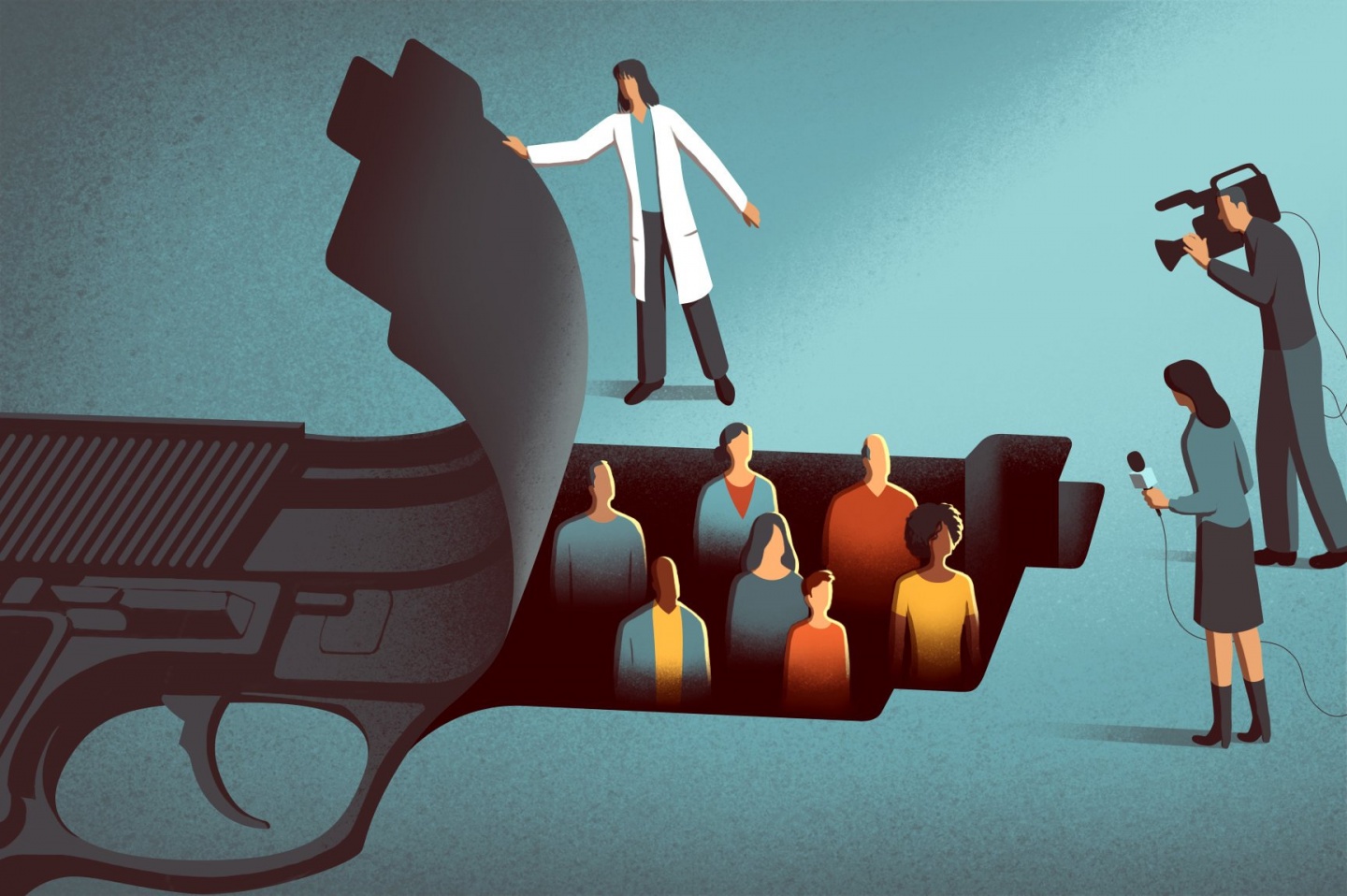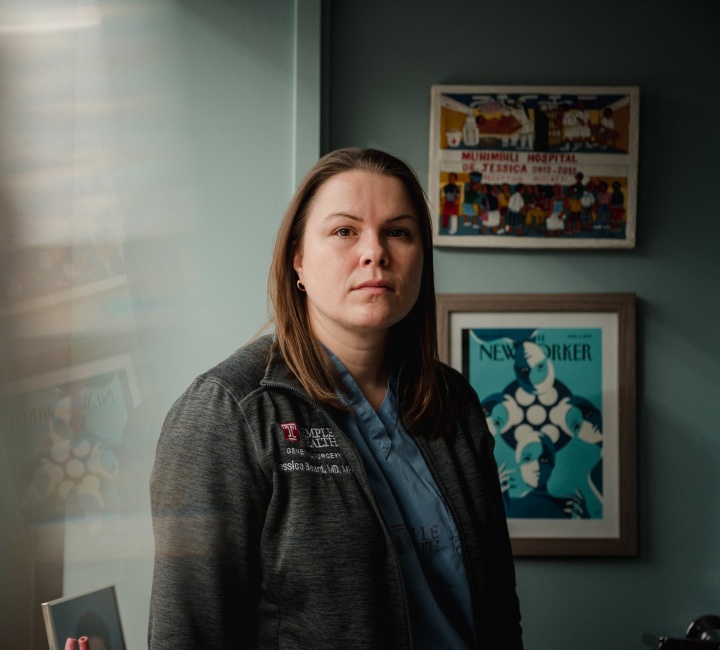CCT talks with Dr. Jessica Beard ’03 about the need for more accurate, ethical crime reporting.
Columbia College | Columbia University in the City of New York
CCT talks with Dr. Jessica Beard ’03 about the need for more accurate, ethical crime reporting.

Davide Bonazzi
When journalists report on shootings in their communities, they tend to follow a predictable pattern: A 25-year-old man was shot near the intersection of Smith and Main streets. He died at the scene, or he was transported to a local hospital. Police have no motives; there have been no arrests. On television, it might take 30 seconds of air time.
But episodic crime reporting, as the approach is known, only offers a narrow keyhole into a complex issue. Trauma surgeon Dr. Jessica Beard ’03 wants to change that. “[It’s] really not the true or accurate representation of gun violence and its impact — on the person who is shot, on their families, on our medical community, and all the anguish that comes with that,” Beard says. “There’s also the perseverance and the resilience of people who get injured and how they recover. The societal toll, the financial toll.”

Dr. Jessica Beard ’03
Hannah Yoon
The Texas-born Beard has long been interested in health equity and social justice. Even as an English major at the College, she knew she was headed for medical school. While at the Yale School of Medicine, she spent a year in Kenya researching the prevention of mother-to-child HIV transmission. Later, she earned a master’s in public health from UC Berkeley. A fellowship in surgical critical care brought her to Philadelphia in 2015; she has been at Temple since 2017.
Beard’s research is unusual for the field, which tends to focus on mass shootings. PCGVR’s findings were included in a recent review, co-sponsored by the Health Alliance for Violence Intervention, which looked at studies of media representations of gun violence since 2000. “It was found that ours were among the few research studies that focused on reporting on community firearm violence,” she says. “But I do think there is a movement — a narrative change movement — when it comes to how we talk about gun violence, how it’s framed, whether it’s inevitable or preventable, and how we understand its root causes.”
This conversation has been edited for length and clarity.
In the mid-1990s there was a surge in gun violence and quite a bit of research coming out about how firearms don’t make you safe, essentially; how they can be harmful to individuals. The NRA wasn’t happy about that and neither were Republican policymakers, and Congress placed a ban on federal funding for gun violence research. This ban, the Dickey Amendment, essentially censored the science and halted that research trajectory. Obama finally lifted the ban, but it took a few years to get grants going. Now the CDC funds gun violence prevention research, as does the NIH, though there is still significant need for more funding to match the disease burden of gun violence. There is a lot of interest in understanding what policies can effectively prevent gun violence and how gun violence is inextricably linked with structural violence and racism.
Unfortunately, in Philadelphia, there was a historic spike in gun violence in March 2020 relating to the pandemic and its containment. In cities around the country, too. The rate of firearm injury actually doubled in Philadelphia compared to pre-pandemic rates, and stayed at that peak level of really horrific numbers through 2021 and 2022. We are now slowly returning to our still unacceptably high rate of gun violence. So that has sparked interest and a desire for prevention.
For me, gun violence and taking care of people who have been shot is very personal. It’s something that I have firsthand knowledge of — as a doctor who takes care of patients and also as somebody who sees the impact that gun violence has on individuals, their families and communities. And so in this landscape of there not being a lot of work in medical circles on gun violence prevention — even as a profession that deals with gun violence as a public health problem — I wanted to understand and do more.
Yes. It’s headed by a former crime photojournalist, Jim MacMillan, who spent decades taking photos at crime scenes and then realized that what he was doing was potentially harmful. He has set about in his life to make gun violence reporting better. There’s a great need for research to inform guidelines for journalistic practice, to elevate the perspectives of firearm-injured people and to minimize harmful reporting. We want to support what PCGVR calls the most ethical, empathetic and impactful reporting on gun violence possible, such that the reporting itself is not part of the problem; it’s part of the solution.
For our first research project we interviewed 26 recently firearm-injured people. It’s important to say that the vast majority of people who get shot do survive, which is another one of the problems with the media narrative: People who get shot and killed are more likely to make the news, so the public doesn’t quite understand what surviving a firearm injury looks like.
We did qualitative interviews, asking them about [their experience with] the reporting of their injuries, and we identified a preponderance of harms that people felt when they saw those crime reports. They felt dehumanized; they were distressed by inaccuracies; they were reliving trauma when graphic content was included. And there were threats to personal safety when certain details were included, for example, the treating hospital.
Very interestingly, people drew a connection between harmful reporting during the pandemic surge in gun violence in Philadelphia and the actual incidence of gun violence. Meaning, there are potential connections between the crime reporting and an environment of fear, and then firearm purchasing — which we know increased during the pandemic and the peri-pandemic period — and finally the actual rate of gun violence. That’s something that’s never been investigated, but this [research] provided a really strong and solid foundation on which to build science around harmful gun violence reporting and better gun violence reporting.
The results inspired a workshop we held in October 2022. We had 60 people representing lived experience, including a patient of mine and his mother, and other folks who lost loved ones to gun violence, along with community leaders and advocates. We also had academic scholars and journalists from all of our local networks — television, radio, newspapers.
We came up with ideas and prototypes, including a toolkit for better gun violence reporting; since then we’ve been able to actually enact that through collaborations. The documentary The Second Trauma, which features our research, was inspired by participation of the people in the workshop.
We also held the first-ever certification workshop for reporters of gun violence prevention in fall 2023. The idea is that this can be a new type of journalism; it’s not the crime beat, it’s the gun violence prevention beat. We are also working with a survivor of gun violence, Oronde McClain, to build connections between journalists and survivors to inform more accurate stories about gun violence.
We have funding from the NIH to continue this line of research. That grant is focused on creating consensus on what is harmful reporting, and then measuring harmful reporting in television news content and examining for race and place-based disparities. But the idea is that harmful reporting on gun violence is a health disparity.
The next phase is to use the tools that we have: the better gun violence reporting toolkit, the documentary and the gun violence reporter certification training. And to actually bring that into newsrooms with the goal of asking that those things be incorporated, to work collaboratively with journalists who iterate and adapt those tools for their setting. And then to measure whether harmful reporting has decreased.
There have been incredible public health successes when it comes to car safety, and smoking and lung cancer. Doctors testified in front of Congress, telling them that smoking causes lung cancer, and through enacting public health measures, smoking rates have decreased. [That took] decades and decades of advocacy [from] public health communities. And I think we’re in that moment with wins and losses with gun violence. From 1998 to the mid 2010s there was very little scholarship, and that was a big loss. But I think we’re coming around the bend, hopefully.

Published three times a year by Columbia College for alumni, students, faculty, parents and friends.
Columbia Alumni Center
622 W. 113th St., MC 4530, 6th Fl.
New York, NY 10025
212-851-7852
cct@columbia.edu

Columbia Alumni Center
622 W. 113th St., MC 4530, 4th Fl.
New York, NY 10025
212-851-7488
ccalumni@columbia.edu